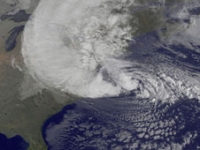Hurricane Sandy has caused widespread power losses up and down the eastern seaboard of the USA, but the region's nuclear plants were prepared to weather the storm.
 |
| Hurricane Sandy approaches the US eastern coast (Image: Nasa) |
As eastern states prepared for the anticipated landfall of Sandy, the US Nuclear Regulatory Commission (NRC) increased oversight at nine nuclear plants in the states of Maryland, New Jersey, Pennsylvania, New York and Connecticut.
Several of the region's nuclear power plants were already in outage. Unit 1 at Constellation's Nine Mile Point was taken off line when an electrical fault occurred on power lines used to send power to the grid, in what the NRC described as "likely a storm-related event". The same fault caused a loss of one of two incoming power lines at Nine Mile Point 2, but the plant's emergency diesel backup generator started up in response to the loss and the unit was able to remain at full power. Operating power was reduced to 73% at Dominion's Millstone 3 in anticipation of high water intake levels, in line with normal operating procedures.
"Nuclear plants are built to exceed the most severe natural forces historically reported for their geographic area. And we saw evidence of that again with Hurricane Sandy."
John Herron
President and CEO, Entergy
One unit at PSEG's Salem nuclear power plant was taken off line when four out of six water-circulating pumps on the non-nuclear side of the plant were rendered unavailable by the impacts of the storm. Salem unit 1 was shut down manually as per normal plant operating procedures. Unit 2 was already offline for a scheduled refuelling outage. PSEG's neighbouring plant at Hope Creek remained at full power.
The NRC reported the declaration of an alert - the second lowest of four NRC action levels - at Exelon's Oyster Creek because of high water levels. A combination of rising tide, wind direction and storm surge was causing a rise in water levels in the plant's intake structure, although the regulator said it expected levels to abate "within hours". The alert will not be lifted until water levels are below those specified for the structure. The unit is currently in a scheduled maintenance outage.
Electrical grid disturbances caused Entergy's Indian Point 3 to shut down automatically, although unit 2 at the plant in New York State continued to operate at full power. "Nuclear plants are built to exceed the most severe natural forces historically reported for their geographic area," said John Herron, president and CEO of Entergy. "And we saw evidence of that again with Hurricane Sandy."
Although Sandy officially dropped just below hurricane status before making landfall, it remains one of the biggest storms ever to hit the eastern USA, with high winds and flooding causing widespread damage leaving estimates of over 30 dead and millions of residents without power.
Researched and written
by World Nuclear News




_18570.jpg)
_16159.jpg)
_18938.jpg)
_33584.jpg)





